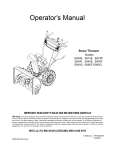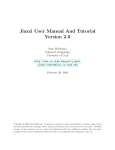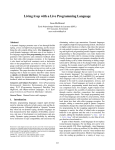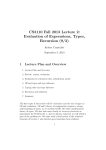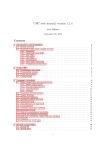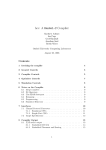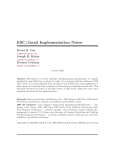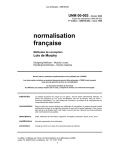Download Optimizing Higher-Order Functions in Scala
Transcript
Optimizing Higher-Order Functions in Scala
Iulian Dragoş1
École Polytechnique Fédérale de Lausanne, Switzerland
Abstract. Scala relies on libraries as the default mechanism for language extension. While this provides an elegant solution for growing the
language, the performance penalty incurred by call-by-name parameters,
boxing and anonymous functions is high. We show that inlining alone is
not enough to remove this overhead, and present a solution based on
decompilation of library code combined with inlining, dead code elimination, and copy propagation. We evaluate our approach on two language
extensions, Java-like assert and C-like for-loops and show improvements
of up to 45%.
1
Introduction
Scala[6] is a statically typed, object-oriented language that brings in functional
programming elements, like higher-order functions and pattern matching. Scala
is designed to be a scalable language, a language that can be used both for
small programming tasks and for building large systems. The ability to grow the
language through libraries is a key aspect. Scala syntax allows users to write code
that looks like built-in features of the language, keeping the language small. For
instance, the standard library provides a BigInt class that is indistinguishable
from the standard Int type, and the for loop on integers is provided through a
Range class.
This approach is elegant and gives users the power of language designers.
However, everything comes at a price, and in this case the price is efficiency.
Familiar looking code, like an assert statement or a for loop may conceal unexpected complexities. While library designers are usually aware of these implications, users are often surprised by such performance hits.
Traditional optimizations techniques, like inlining are not very effective. Code
is often spread across several compiled libraries, and many short-lived objects
on the heap make analysis harder. The Scala compiler is complementing the
traditional optimizations with a boxing optimization (that removes unnecessary
boxing and unboxing operations), a type-propagation analysis (that obtains more
precise types for values on the stack and local variables) and a copy-propagation
optimization (that has a simple heap model handling common object patterns
like boxed values and closures). All these would be of little use for library code,
unless the compiler had a way of analyzing libraries. The Scala compiler is using
an icode reader for reading back compiled code into the intermediate representation on which the optimizations are run.
The next section shows an example and discusses the sources of inefficiencies.
Section 3 discusses the proposed solution and looks into the difficulties we faced
in implementing it. Section 4 presents a preliminary evaluation and the last
section concludes and presents directions for future research.
2
Example
2.1
Elements of Scala syntax
Before we show the examples, we quickly mention a few language features that
will be needed later. For an in-depth description of the language, we recommend
[6] or [3]. Scala is a class-based, object-oriented language. It’s syntax should be
familiar to Java and C++ programmers, although some familiar concepts are
expressed slightly differently.
class List[A] extends Seq[A] {
private var len: Int = 10
def length: Int = len
def map[B](f: A => B): List[B] = //..
def foreach(f: A => Unit): Unit = //..
//..
}
val xs: List[Int] = ..
xs foreach { x: Int => println(x) }
for (x <- xs) println(x)
Fig. 1. A Scala syntax show case
Figure 1 shows part of a List implementation. List takes a type parameter, the type of its elements, and extends Seq, the type of sequences of type A.
Type parameters are introduced by square brackets, instead of angle brackets in
Java/C++. Fields or local variables are introduced by val or var, the first one
denoting a value that cannot be assigned after it has been initialized. Types are
introduced by colon, and in many cases can be omitted; the type inferencer fills
in the most precise type. Methods are introduced by def and may omit parenthesis when they take no parameters. Higher-order functions take as parameters
or return other functions. Both foreach and map are higher-order functions1 .
The next lines show two ways in which foreach can be called. The first one is
a direct call, making use of Scala’s support for infix calls: when a method takes
a single parameter, the user may omit the dot and the parenthesis around the
argument. The argument is a unary anonymous function, delimited by braces.
1
Although technically they are methods, we use the established terminology in functional programming and call them higher-order functions.
The arrow separates the parameter section from the function body. As mentioned
before, the type annotations may be dropped. The last line has exactly the same
meaning, but uses for-comprehensions to iterate over the elements of xs. The
compiler desugars it to the previous line.
For-comprehensions are a very general mechanism for operating on sequences.
In its most general form a for-comprehension may contain any number of generators and filters. For instance,
for (i <- xs; j <- ys; if (i % j == 0)) print(i, j)
prints i and j only when i is a multiple of j. The first two statements are
generators, that bind i and j to each element of xs and ys respectively. This
is achieved by translating the given comprehension into a series of foreach,
filter (braces were omitted for clarity):
xs.foreach(i =>
ys.filter(j => i % j == 0).foreach(j => print(i, j)))
2.2
Examples
We begin by showing how the assert keyword from Java can be implemented in
Scala as a library function. The tricky part consists in the requirement that the
condition and message should not be evaluated unless assertions are enabled, and
the assertion fails, respectively. In a strict language like Java, and in the absence
of macros, this is impossible to express in the language. Scala offers call-by-name
parameters, which turn arguments at each call site into nullary functions. The
body of the method applies the function each time it needs to obtain the value.
def assert(cond: => Boolean, message: => Any) {
if (assertionsEnabled && !cond)
throw new AssertionError("assertion failed: " + message)
}
Fig. 2. Predef.assert
Figure 3 shows how call-by-name parameters are compiled. Calling assert
implies loading two new classes and instantiating an object for each, which might
never be used, or if it is used, it is collect-able immediately after returning from
assert. What makes things worse, is that this happens at each call site: clearly,
such code is going to put a lot of pressure on the garbage collector, and the
benefits of not evaluating arguments might be lost completely.
Closures are compiled by turning them into classes that implement one of the
FunctionN interfaces, where N is the arity. The captured environment is saved as
fields of the closure class, and passed as arguments to the constructor. A slight
def sqrt(x: Int): Int = {
assert(x >= 0, "Expected positive integer: " + x)
//..
}
def sqrt(x: Int): Int = {
assert(new anonfun1(x), new anonfun2(x))
//..
}
final class anonfun1 extends Function0[Boolean] {
private val x: Int = _
final def apply: Boolean = x >= 0
}
final class anonfun2 extends Function0[String] {
private val x: Int = _
final def apply: String = "Expected positive integer: " +
}
x
Fig. 3. Using assert
complication is caused by environments that contain vars. In order to allow the
closure to modify that value, vars are wrapped in a reference object that provides
methods for changing the value it holds. For simplicity, none of the examples in
this paper use mutable variables.
Our second example is looking at for loops on integer ranges, as seen in most
imperative languages. As mentioned before, Scala has no special compiler support for such loops, providing a library class that implements foreach and filter.
Therefore, the ubiquitous for loop on integers relies on the for-comprehension
machinery, requiring a lot of temporary objects and indirection.
Figure 4 shows an example, including desugaring. In addition to for comprehension desugaring, this example shows another feature that allows users to
extend the language in seamless ways: 1 until 10 is translated to a method call
on the Int class, and since there is no method until in scala.Int, an implicit
conversion is applied first. Method intWrapper wraps a primitive integer into
a RichInt, which has the required methods for creating ranges. The result of
intWrapper(1).until(10) is a Range object that supports iteration. Note that
each integer in the loop needs to be unboxed before being applied to the body
of the loop.
3
Optimizations
The Scala compiler has several optimization phases that target such cases. The
goal is to improve both running time and code size. As shown in the examples above, higher-order functions and anonymous functions are very common,
def loop {
for (i <- 1 until 10) print(i)
}
// desugars to
def loop(): Unit =
intWrapper(1).until(10).foreach(new anonfun3())
final class anonfun3 extends Function1[Unit, Int] {
final def apply(i: Int): Unit = Predef.print(Int.box(i));
final def apply(x1: Object): Object = {
apply(scala.Int.unbox(x1));
scala.runtime.BoxedUnit.UNIT
}
}
Fig. 4. For loops on integer ranges.
making it important to keep their numbers down by optimizing them away in
statically-known contexts. This can improve running time as well, since class
load time and verification on the Java VM are expensive.
The optimization phases are ran on an intermediate representation (icode)
that is close to the target code (Java bytecode or .NET IL). icode is stack based,
and uses a control–flow graph of basic blocks to facilitate data flow analysis. One
of its goals is to make it easy to read back icode from compiled code.
In a first phase, methods are inlined. Then a closure elimination tries to
remove all references to the closure object (or environment). A dead–code elimination pass removes unnecessary assignments, mainly coming from the inlining
phase, and all unreferenced closure objects (including their class).
3.1
Inlining
The inlining phase uses a fairly expensive analysis to derive precise types for
local variables and stack positions. It is an intraprocedural, forward data flow
analysis, which uses the Scala type lattice to derive values at each program point.
The goal of this analysis is to resolve method calls. Since we are not relying on
a whole–program analysis, the inliner can inline only final methods. This is not
a problem in our main cases of interest, closures: they are always final classes
that extends a FunctionN interface.
Class Hierarchy Analysis (CHA) and Rapid Type Analysis[2, 1] are reported
in literature to give very good results in practice. It proceeds by removing from
the class hierarchy those classes that are never instantiated. However, in our
case this does not help, as each anonymous class is instantiated exactly once.
Therefore, all method calls to a FunctionN apply method are truly polymorphic.
Instead, our analysis aims to derive the most precise type possible for the receiver
object. It turns out that in most cases this is the anonymous function type, which
is final and statically known.
The decision to inline is taken based on method size (calls inside small methods are usually poor choices, as the Java VM native compiler favors small methods). Higher–order methods are preferred for inlining, as they usually allow complete elimination of their argument. In Figure 4, inlining method foreach allows,
in a next step, to inline the anonymous function given as argument (anonfun3).
The analysis and inlining phase are repeated until a fix point is reached (no
more methods can be inlined) or a size limit is reached. This ensures reasonable
compilation times and method sizes (as mentioned before, large methods take a
penalty hit as the JIT compiler seems to be more reluctant to compile them).
3.2
Closure elimination
This phase is trying to infer what values passed in the closure environment
can be accessed from the method environment. In other words, the analysis tells
whether fields of the anonymous class can be proved to be the same as some local
variable available in the enclosing method. This case is common after inlining
both a higher order function and the closure’s apply method.
The analysis is similar to reaching definitions, but it adds a simple model of
the heap: in addition to local variables and stack positions, values of objects on
the heap that are reachable from locals or stack are modeled as simple records.
Such records are populated when known constructors are invoked. For now the
only constructors that can create non–empty records on the heap are closure
constructors (which populate the record with the captured environment), case
class constructors (which populate the record with the given case arguments) and
box methods (which populate the record with a single field, the boxed value).
Once the analysis has determined copy–of relations between locals and values
on the heap, it proceeds at replacing them by the cheapest operation. At the
end of this phase, boxed and closure objects may be unreferenced, and it is the
next phase which cleans them up.
3.3
Dead–Code Elimination
The last optimization phase is cleaning up dead code. It uses a standard mark
and sweep algorithm: in a first phase, useful instructions are marked, then in
a second phase all instructions not marked are removed. Special care must be
taken to keep the stack valid, by adding necessary DROP instructions. Some of
them might prove useless later, and a peephole optimizer is run as the very last
operation before code generation.
To mark useful instructions, the algorithm starts with instructions that are
known to be needed, like RETURN and side–effecting methods. Then, based on
reaching definitions, it recursively marks all instructions that create the definitions used by marked instructions. If at the end of this phase there are unreferenced closure classes, they are removed completely.
Test Case Running time (ms) Optimized (ms) Speed up
assert
104.8 (0.84)
67.4 (0.55)
36%
assert (disabled)
79.6 (0.55)
44.4 (0.55)
44%
matrix
75.4 (0.55)
40.4 (0.55)
46%
Fig. 5. Evaluation: running time improvements. Times are average over 5 runs, standard deviation is given in parenthesis.
3.4
Icode Reader
In order to handle library code, the optimization phases have to be able to get
back an icode representation. The current Scala compiler has a Java bytecode
reader that is integrated in the optimization phases2 .
The Java bytecode reader has to solve several aspects in order to integrate
with the optimization passes: symbol recovery and typing locals. Symbol recovery means that each symbol coming from the bytecode has to be resolved in the
compiler’s symbol table. This is not trivial, as compilation of Scala–specifics like
traits is fairly involved: each trait generates an interface and an implementation
class. Reading back one of them should actually read both, and reuse existing symbols whenever the same entity is referred. For example, reading back a
method implementation that calls a method that is currently compiled should
reuse the symbol that the compiler created in the earlier phases.
Unlike Java bytecode, icode uses typed local variables. When reading code
using the same location for values of different types, the bytecode reader splits
the local in two different locals. The approach is similar to the approach taken
by the Soot framework[7].
4
Preliminary Evaluation
In this section we present preliminary results using the described optimizations.
We believe these results are only preliminary, and significant improvements are
still possible. However, they are still mini benchmarks, and we don’t expect
speedups of this scale on usual programs. A more thorough evaluation is necessary to truly assess the effectiveness of these optimizations.
Time measurements are done using System.currentTimeMillis, and each
benchmark has been run once to warm up the VM before the actual measurement
was taken. All tests were run on an Intel Core Duo at 2.5 GHz processor with
2 GB of RAM, running MacOS 10.5.2 and Java 1.5.0_13. Each measurement is
the mean over 5 runs, with the standard deviation shown in parenthesis.
2
In order to keep compilation times low, it is enabled only on certain scala libraries.
Once it becomes more mature and performance issues are solved, it will be enabled
on all code.
4.1
Assert
The test case for the assert method was to run 500, 000 times code containing
several simple assertions, with assertions disabled and then enabled. The code is
shown in Figure 6. Bytecode inspection showed that closures for both arguments
have been eliminated completely.
4.2
For loops
For evaluating for–loops performance we used a simple integer matrix multiplication algorithm. The code is shown in Figure 6 (as Scala compiles to the Java
Virtual Machine, it inherits its model of arrays: multi-dimensional arrays are
implemented using one-dimensional arrays). We used a slightly modified version
of the Scala Range class, in order to have foreach marked final. This version is
likely to be included in the next Scala release.
def multiply(n: Int, a: Array[Array[Int]], b: Array[Array[Int]]) {
val c: Array[Array[Int]] = new Array(n, n)
for (i <- 1 until n; j <- 1 until n; k <- 1 until n)
c(i)(j) += a(i)(k) * b(k)(j)
}
// assert test
def test(xml: Node) {
assert(xml.label == "persons", "Wrong Xml root element: " + xml)
test2(xml.label)
}
def test2(label: String) {
assert(label == "persons", "Wrong Xml root element: " + xml)
test3(label.length)
}
def test3(size: Int) {
assert(size == 7, "Wrong Xml root element: " + xml)
}
Fig. 6. Matrix multiplication (for simplicity, we assume square matrices).
Bytecode inspection shows that all boxing has been removed, and closures
have been inlined. The speedup can be seen in Figure 5.
5
Future work
The analysis used by the inliner is expensive, and we are looking at ways to speed
it up. Since inlining is applied repeatedly, we think a form of incremental data
flow analysis should help. Currently, at each step, after one method has been
inlined, a solution for the data flow equations is recomputed from scratch. The
control flow graph is changed by replacing one method call by its own control
flow graph, so large parts are similar. We believe a solution based on reusing
partial results from previous solutions can speed it up considerably.
References
1. David F. Bacon and Peter F. Sweeney. Fast static analysis of C++ virtual function
calls. pages 324–341.
2. Jeffrey Dean, David Grove, and Craig Chambers. Optimization of object-oriented
programs using static class hierarchy analysis. Lecture Notes in Computer Science,
952:77–101, 1995.
3. Bill Venners Martin Oderksy, Lex Spoon. Programming in Scala. artima, 2008.
4. Steven S. Muchnick. Advanced Compiler Design and Implementation. Morgan Kaufmann, August 1997.
5. Flemming Nielson, Hanne R. Nielson, and Chris Hankin. Principles of Program
Analysis. Springer-Verlag New York, Inc., Secaucus, NJ, USA, 1999.
6. Martin Odersky, Philippe Altherr, Vincent Cremet, Iulian Dragos, Gilles Dubochet, Burak Emir, Sean McDirmid, StÃľphane Micheloud, Nikolay Mihaylov, Michel
Schinz, Lex Spoon, Erik Stenman, and Matthias Zenger. An Overview of the Scala
Programming Language (2. edition). Technical report, 2006.
7. Raja Vallée-Rai, Laurie Hendren, Vijay Sundaresan, Patrick Lam, Etienne Gagnon,
and Phong Co. Soot - a java optimization framework. In Proceedings of CASCON
1999, pages 125–135, 1999.









